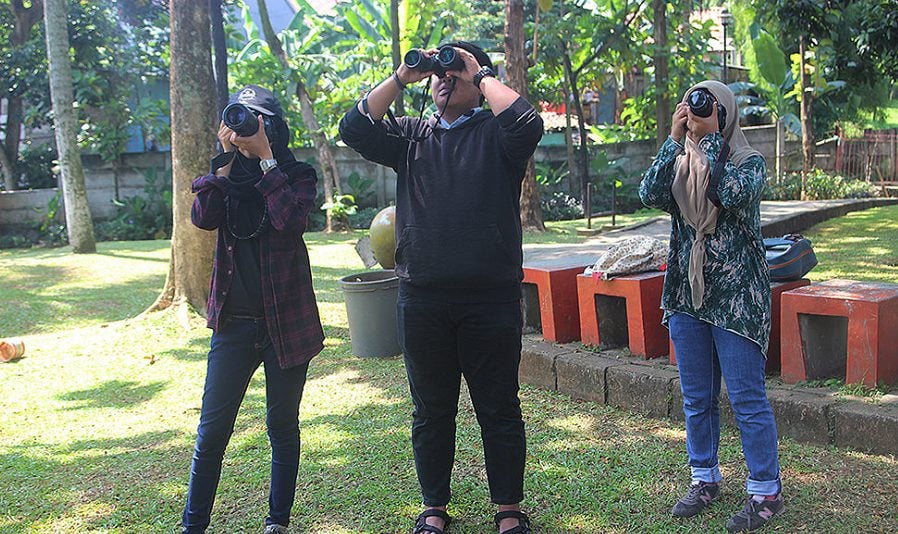Celebrating International Biodiversity Day, Biodiversity Warriors organized a ‘Capture Nature’ event at Dadap Merah park

-
Date:
30 Apr 2020 -
Author:
KEHATI
The changes jotted down by development in DKI Jakarta Province are impacting the City of Jakarta’s ecosystem. The most noticeable change? The visible dwindling of green open spaces (RTH) as they get converted into residential buildings and towering skyscrapers.
As for the changes in the green space front, the past few decades have seen a considerable shrinkage. The Jakarta General Spatial Planning Plan (RUTR) recorded that, from 1965 to 1985, green open spaces comprised 37% of Jakarta’s total area. The following RUTR, from 1985 to 2005, showed a decline to 25.82%. Lastly, the 2000-2010 Regional Spatial Plan (RTRW) showed only 13.94% of Jakarta had remaining open space.
What’s the big worry here? The decrease in green spaces is alarming as it can potentially affect the survival and variety of species in urban areas. What’s worse, it brings about bigger threats like hunting and illegal trading of wildlife in urban zones. This issue, ripe with complexities, certainly deserves to be the subject of deeper research.
Jakarta’s Green Spaces: A Closer Look
Right now, Jakarta has only around 9% of its total area dedicated to green spaces which is pretty low. As per Law Number 26 of 2007, concerning Spatial Planning, it should actually be 30% to maintain a healthy city ecosystem. This 30% minimum helps balance out things like hydrological systems (which can help prevent floods), and boost the availability of clean air. So, Jakarta has a long way to go to reach that green dream.
Even though Jakarta is often associated with high pollution levels, it’s amazing to see how its green spaces still thrive. The city nurtures a bunch of cool and intriguing species thereby creating an attractive biodiversity. This could almost be seen as an invite for folks to visit these green spaces and find positive ways to use them.
These green spaces aren’t just vital for the city’s well-being, but they are also a little nudge to the government. A nudge to remember that increasing green space is a necessity, not something optional. Green is the way to go!
To kick off World Biodiversity Day which is held on the 22nd of May, Biodiversity Warriors and KEHATI Foundation embarked on the “Capture Nature” project. This included an exhibition and a wildlife photo competition at Taman Dadap Merah, situated in Kebagusan, South Jakarta, which took place on Saturday the 5th of December. This year, the theme of World Biological Diversity Day is ‘Celebrating 25 Years of Action for Biodiversity’.
“Capture Nature” is all about documenting biodiversity. This includes everything from fungi to plants, along with urban wildlife that reside in an area.
Ahmad Baihaqi, an Education & Outreach staff member from the KEHATI Foundation, stated that the aim of this initiative is to keep tabs on the many types of macro fungi, plants, and urban wildlife that are found in Dadap Merah Park. The plants that have been identified are crucial for park wildlife, serving as a food source. As for the animals, you’ll find everything from dragonflies and butterflies to a diverse range of herpetofauna (meaning reptiles and amphibians), birds, and mammals.
Abay, also known as Ahmad Baihaqi, a student at the Biology Master’s Study Program at the National University Postgraduate School in Jakarta, emphasized that this initiative doesn’t just aim to create a space. It’s also about boosting public awareness and understanding of urban biodiversity’s crucial role.
It’s worth mentioning, people from all walks of life have been really keen about this project. A range of groups within the community, from student societies to environmental services, have taken part. Biodiversity Warriors volunteers from the KEHATI Foundation and the Biological Bird Club (BBC) Ardea showed up in their dozens, as well as representatives from the Faculty of Biology, National University (FABIONA), and the Nycticorax UNJ Jakarta Bird Watchers Group (KPB).
The Macaca UNJ Jakarta Primate Study Group (KSP), the Comata UI Wildlife Study Group (KSHL), and the Biology Masters students from the National University Postgraduate School were also there. Not to forget the DKI Jakarta Watershed Forum (DAS), the Cikal School team, and the guys from the DKI Jakarta Provincial Environmental Service. They all turned out to support this event.
Our awesome volunteers at Dadap Merah Park hike all around, sticking to existing trails and covering every nook and cranny of the place. They’re on the lookout for all kinds of cool biodiversity – from fascinating macro fungi and plants to all sorts of wild critters.
Whenever they stumble upon such biodiversity, our volunteers take a 15-minute break. This isn’t for coffee, but to closely observe, identify and jot down the kind and number of species they’ve spotted.
We then share this precious data on our website, www.biodiversitywarriors.org. From here, the fine folks at the KEHATI Foundation help us spread this important info far and wide, reaching folks who are making policies, doing scientific research, and running environmental organizations.
Abay, a keen advocate of our work, dreams to see every patch of green equipped with a signboard. One that proudly showcases all the biodiversity that calls that patch home and another one that firmly says ‘No Hunting’. He’s hopeful that more awareness would lead to better care of our green spaces and their inhabitants.
